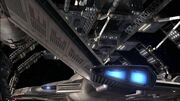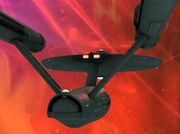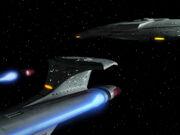Pseudohuman (talk | contribs) m (→Technology: + other unwrittens) |
Pseudohuman (talk | contribs) m (→See also: +1) |
||
| Line 46: | Line 46: | ||
== See also == |
== See also == |
||
* [[Hyper-impulse drive]] |
* [[Hyper-impulse drive]] |
||
| + | * [[Sub-impulse thruster]] |
||
== Background == |
== Background == |
||
Revision as of 19:05, 25 July 2011

A close-up of the NX class impulse drive

USS Enterprise NCC-1701 using impulse engines to maintain thrust against the space amoeba
A close-up of the refit Template:ShipClass ship impulse engines

Impulse engine on an alternate reality Template:ShipClass ship

The impulse engines on a Template:ShipClass starship
- You may be looking for the Enterprise episode "Impulse".
- "One-quarter impulse power."
The impulse drive was a common propulsion system used on starships to achieve high sublight speeds.
Technology
In Federation starships, the impulse drive was essentially an augmented fusion rocket, usually consisting of one or more fusion reactors, an accelerator-generator, a driver coil assembly, and a vectored thrust nozzle to direct the plasma exhaust. The fusion reaction generated a highly energized plasma. This plasma, ("electro-plasma") could be employed for propulsion, or could be diverted through the EPS to the power transfer grid, via EPS conduits, so as to supply other systems. The accelerated plasma was passed through the driver coils, thereby generating a subspace field which improved the propulsive effect.
In 2267, Science Officer Spock calculated the explosive force of an overloaded Starship-class impulse engine to be 97.835 megatons. (TOS: "The Doomsday Machine")
By the 2270s, impulse was capable of sustaining warp 0.5 without the warp drive even being on-line. (Star Trek: The Motion Picture)
The impulse drive of Bajoran interceptors could not operate within an atmosphere. (DS9: "The Siege")
The type 15 shuttlepods were equipped with two long range 750 millicochrane impulse driver engines, also known as impulse nacelles, which were located on either side of the craft. (TNG: "In Theory", "Descent" display graphic)
Several ships, including Jem'Hadar fighters, Galileo-type shuttlecraft; Template:ShipClass runabouts, the Delta Flyer II and Class V planetary probes use impulse thrusters for sublight propulsion. (Star Trek V: The Final Frontier; DS9: "Rocks and Shoals", "The Assignment"; VOY: "Drive", "Blink of an Eye") Magnetic constrictors were a component in the Danube-class impulse thrusters. (DS9: "The Assignment")
Parts of the system
- Avidyne engine
- Accelerator-generator
- Driver coil
- Impulse capacitance cell
- Impulse control system
- Impulse jet
- Impulse manifold
- Impulse matrix
- Impulse nacelle
- Impulse pack
- Impulse reactor
- Impulse thruster
- Primary drive coil
- Radioactive disposal vent
- Torque buffer
See also
Background
Dialogue from several episodes, including "Where No Man Has Gone Before" and "The Doomsday Machine", suggests that the impulse drive could be used in some manner to propel a ship at faster than light speeds, albeit with a lower maximum speed and a higher rate of fuel consumption than the main warp drive. This could possibly make the relationship between impulse and warp drive analogous to the relationship between electric and combustion engines in a modern hybrid car. It would also explain Scotty's remark in "Balance of Terror" about the Romulans' power being "simple impulse" and allow it to be reconciled with their clear capacity for interstellar travel.
In The Motion Picture, The Enterprise traveled at warp 0.5 from Earth to past the planet Jupiter, a distance of (at a minimum) 390,674,900 miles, in 1.8 hours, making that speed approximately equal to 97,026 kilometers per second (217,041,611 miles per hour), or roughly 1/3 light speed. The difference may be explained by differences in orbital precession between the two planets at the time, or, as with warp drive, there may be other variables involved.
According to Jo'Bril in the episode "Suspicions", the shuttles aboard the Enterprise-D had a maximum impulse velocity of approximately 2.5% of light speed – he specified that at ¾ impulse the shuttle would travel a distance of one million kilometers in approximately three minutes (approximately 12,400,000 miles per hour).
A reference made in "Fair Haven" indicated that USS Voyager's impulse power would not be enough to outrun an approaching neutronic storm that was traveling at a velocity of 200,000 kilometers per second (447,387,258 miles per hour), or roughly 2/3 the speed of light. However, it is also commented in "Timeless" that at full impulse, Voyager could travel at roughly 80% light speed.
